THAILAND
Population

Population
Cities in THAILAND
| Bangkok |
Population
Composition and distribution
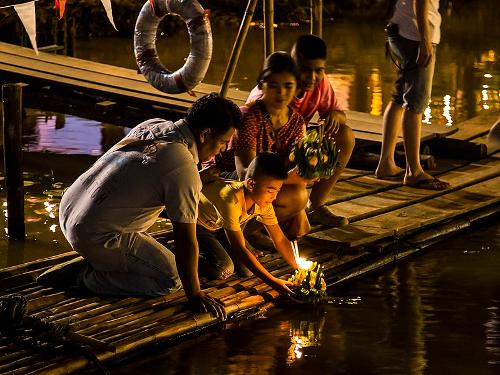 ThaiPhoto: John Shedrick CC 2.0 Generic no changes made
ThaiPhoto: John Shedrick CC 2.0 Generic no changes made
The inhabitants of Thailand are descendants of the many peoples who came here from all over the world. The current population consists of 97.5% Thai, who come from Southwest China and moved to Thailand in the 13th century. The Middle Thai (the Siamese) are the largest group and live on the central plain and in the delta of the Chao Phraya River. The closely related South Thai (Thai Pak Tai), the Lao and the North Thai are other large Thai populations. The Shan (Thai Yai) are also related to the Thai and inhabit the hills to the northwest, along the border with Myanmar. Another Thai population, the Thai Lu lives in the vicinity of Changrai.
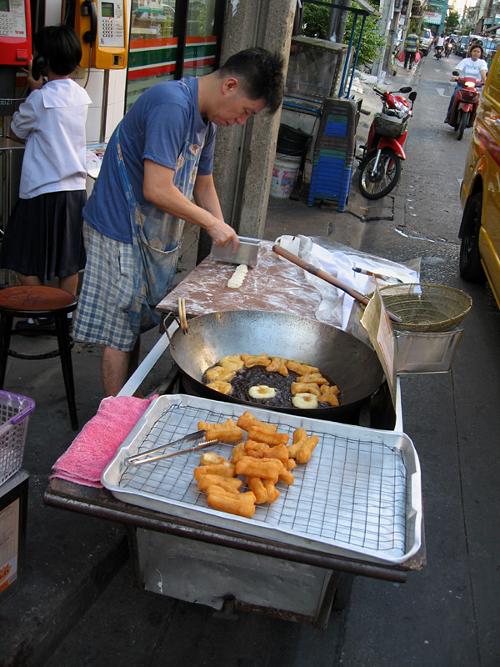 Chinese street food seller in ThailandPhoto: Furibond CC 2.0 Generic no changes made
Chinese street food seller in ThailandPhoto: Furibond CC 2.0 Generic no changes made
The main minority group is formed by the Chinese (Sino-Thai), who have an important share in trade, banking and transport. However, most of them are of Thai nationality and have integrated into Thai culture without much difficulty. The first Chinese immigrants came to Thailand as merchants in the 14th century. In the late 18th and early 19th centuries, after long years of war, the immigration of Chinese was encouraged, as they could help rebuild the economy.
In the south, Malays live, who know their language (Malay) and religion (Islam) as a minority group. In the south they are the largest population group. The Muslim Malay Thai feel oppressed by the Buddhist Thai and in response, an Islamic resistance movement arose that does not shy away from attacks. The Sikhs, from the Punjab, dominate the textile trade.
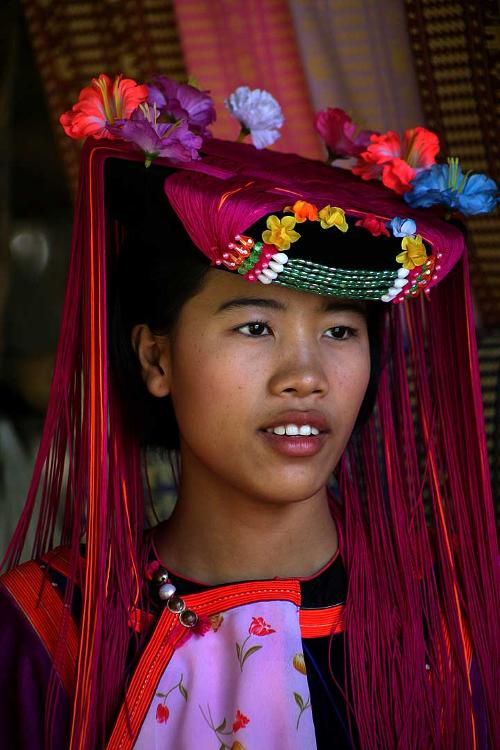 Lisu, ThailandPhoto: Steve Evans CC 2.0 Generic no changes made
Lisu, ThailandPhoto: Steve Evans CC 2.0 Generic no changes made
In the mountains in the north live a number of so-called mountain peoples (collectively 'Chao Khao' or 'hill tribes'), such as the Karen, Meo , Yao, Lawa, Lahu, Lisu and Akha. They live in the area called the Golden Triangle, the rugged region where Thailand, Laos and Myanmar meet. They only make up about 1-1.5% of the total population of Thailand, but because of their language, religion and clothing, they stand out the most and are the least integrated. The mountain peoples are spread over 3,500 villages in some fifteen provinces. Originally they were animists, but most were Christianized by missionaries and others converted to Buddhism. The area is also known for the cultivation of poppy, the plant from which opium is made. At the moment, the government is trying, with reasonable success, to get them to grow products other than poppies. For example, since 1965, there have been no poppy fields in the real 'Golden Triangle', on the banks of the Mekong, where the actual three-country point is located. The authorities have replaced them with other crops: coffee and tobacco.
The Lisu or Lissou live the highest, around 1800 meters, and spread over 80 villages. This Tibetan-Burmese people have had to do without any form of writing for centuries. They are farmers and also earn well from opium cultivation. They are highly affectedChinese culture and also celebrate the Chinese New Year for example.
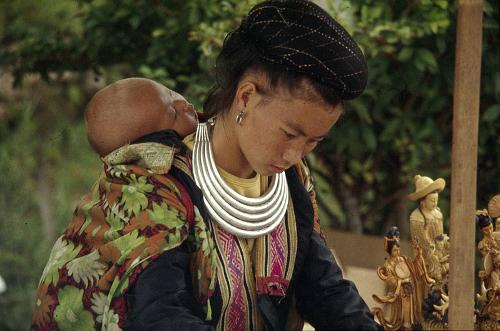 Meo woman with child, ThailandPhoto:Gerd Eichmann CC 4.0 International no changes
Meo woman with child, ThailandPhoto:Gerd Eichmann CC 4.0 International no changes
The Meo (Hmong) initially lived in the mountains of China and Laos. They speak a tonal language and have no writing. Their history is laced with revolts against central authority. As a result, they were driven further and further south and ended up in the north of Thailand, in the triangle Tak-Chinag Mai-Nan. The Thai group has about 38,000 members who live in 148 villages. The Meo can be divided into three subgroups: the Blue Meos, the White Meos and the Guas Mbas-Meos. Their religion is a combination of pantheism and shamanism.
The total people of the Yao or Mien number several million souls, scattered across the mountainous region of Southeast Asia. In Northeast Thailand, at an altitude of 1000-1300 meters, about 20,000 live in more than a hundred villages in the provinces of Chiang Rai and Nann.
The 40,000 Akha, of Tibeto-Burman origin, have settled since early twentieth century in Mae Chan and Mae Sai districts. In government circles the Akha are considered the most primitive group; they can neither read nor write. They live in the mountains and grow opium there, as well as rice, corn, millet, vegetables and raise animals: poultry, pigs and buffaloes. Favorite dish: dog soup. The Akha are pantheists, for which ancestor worship and sacrifices are important events.
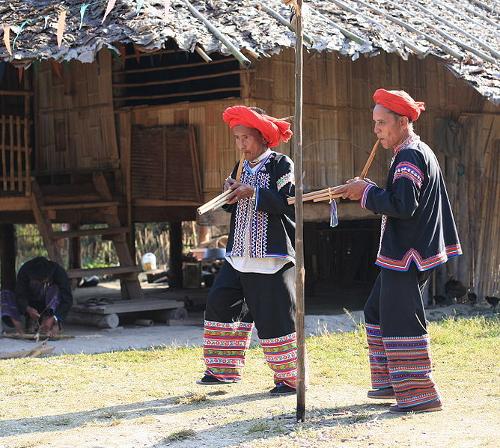 Lahu, ThailandPhoto:Steve Jurvetson CC 2.0 Generic no changes made
Lahu, ThailandPhoto:Steve Jurvetson CC 2.0 Generic no changes made
The Lahu live in 160 villages between Chiang Mai, Chiangrai and Mae Hong Son. There are four different groups, including the Lahu Shi, Lahu Nyis and the Lahu Nas. The Lahu grow opium, rice and corn, but they are also pastoralists and especially hunters with a bow and arrow. They live in villages far apart, usually quite high in the mountains.
The Lawa or Lue are only found in Thailand and have been living in Northern Thailand since 660. Most now live in the border area with Myanmar in the area between Mae Hong Son and Mae Sariang. They adhere to a mixture of Buddhism, animism and ancestor worship.
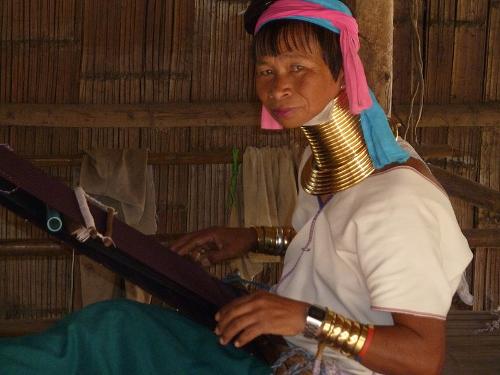 Karen, ThailandPhoto: Deror Avi CC 3.0 Unported no changes made
Karen, ThailandPhoto: Deror Avi CC 3.0 Unported no changes made
The Karen, the largest mountain people, live here and there along the border and the different groups within this tribe are distinguished from each other by the color of the women's clothes, the dialect, religion and the long necks of the women. Some groups have turned to Christianity. The Karen are divided into four subgroups: the Saw Karen or White Karen, the Pwo Karen or Plong, the Taungthus or Black Karen, and the Kayahs or Red Karen.
The youngest mountain people in Thailand are the Kwo Min Tang. They belonged to the army of the Chinese general Chiang Kai Chek, who fought against the communists of Mao tse Tung. When he was defeated in 1949, some of his followers fled to Myanmar and Thailand. There are said to be tens of thousands of KMT Chinese living in 64 villages in Thailand's five northern provinces.
Small groups are the Khamus, the Htins, the Lawas and the Mrabris, also known as Phis Thongs Luangs. The Mrabris is North Thailand's most isolated living hill tribe and these hundreds of nomadic hunters in all were only discovered a few decades ago. Their dead are not buried, but hung in trees to be eaten by birds.
The densely forested mountainous region of Mae Hong Son province in northern Thailand is still home toa special group, the Padong. They are related to the Karen and have only been present in this area since the 1950s. Like other Karen tribes, they revolted against the junta in Myanmar and were forced to flee. are often exploited in that sense. On the other hand, tourism is their only source of income, because as refugees they do not have the right to engage in agricultural activities.
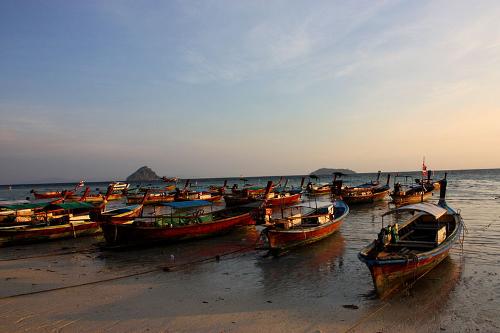 Ships from Sea Gypsies, ThailandPhoto: Kjfmartin at en.wikipedia CC 3.0 Unported no changes made
Ships from Sea Gypsies, ThailandPhoto: Kjfmartin at en.wikipedia CC 3.0 Unported no changes made
In southern Thailand, there are still some small populations, such as the NGOs and the Chao Lae or Chanam, also known as sea gypsies. They live from fishing and selling precious shells. These sea gypsies may come from the Andaman or Nicobar Islands just across the Andaman Sea. Phuket's sea gypsies settled in the area some 200 years ago. They came from the Mergui Archipelago west of the Burmese mainland. There are three ethnic groups: the Moklen, the Moken and the Urak Lawoi.
Sea Gypsies live in the Andaman Sea area on Ko Surin, Ko Phra Tong in Phangnga and further on the islands of Phi Phi, Lanta , Talibong, Tarutao and Langkawi. They have their own language and an animistic belief. The Thai government does not regard them as citizens and therefore they have no political rights and no guaranteed security.
Finally, Thailand had several hundred thousand refugees from Cambodia, Vietnam and Laos. They had fled their country as a result of wars and oppressive regimes. In 1992 and 1993, Cambodian refugees returned to their country accompanied by the United Nations.
Along the 2,500 km long border with Myanmar are more than 100,000 to the Burmese ethnic minorities Karen, Mon and Karenni belong to refugees in refugee camps.
An estimated 1.3 million foreign workers, 986,000 of whom are illegal, live in Thailand.
Demographics
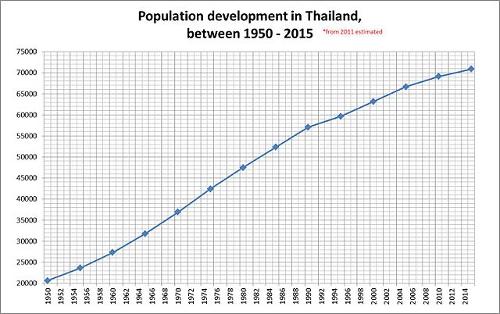 Thailand's population (1950-2015)Photo: World24 at German Wikipedia CC 3.0 Unportedno changes made
Thailand's population (1950-2015)Photo: World24 at German Wikipedia CC 3.0 Unportedno changes made
On November 2, 1996, the 60 millionth resident of Thailand was officially born. In 2024 Thailand has 70 million inhabitants, of which about half live in cities. By placing a strong emphasis on family planning, population growth was reduced to less than 1.5% per year. The population growth was 0.17% in 2017.
Life expectancy for men in 2017 was 75.7 years, for women 81.3 years.
The average population density is approximately 140 inhabitants per km2, but the population is very unevenly distributed across the country. The northern highlands have the lowest population density, the central lowlands and the southern part of the peninsula are densely to very densely populated.
The largest city is Bangkok with around 11 million inhabitants (2024).
Sources
Clutterbuck, M. / Thailand
Van Reemst
Davies, B. / Thailand
Kosmos-Z&K3
Forbes, A. / Thailand
Kosmos-Z&K
Hahn, W. / Thailand
Van Reemst
Hauser, S. / Thailand : mensen, politiek, economie, cultuur, milieu
Koninklijk Instituut voor de Tropen
Hoskin, J. / Thailand
Van Reemst
Macdonald, P. / Thailand
Kosmos-Z&K
Miethig, M. / Thailand
Lannoo
Peterse, L. / Thailand
Gottmer/Becht
Steinmetz, P. / Thailand
Elmar
Thailand
Uitgeversmaatschappij The Reader’s Digest
Thailand
Lannoo
CIA - World Factbook
BBC - Country Profiles
Copyright: Team The World of Info